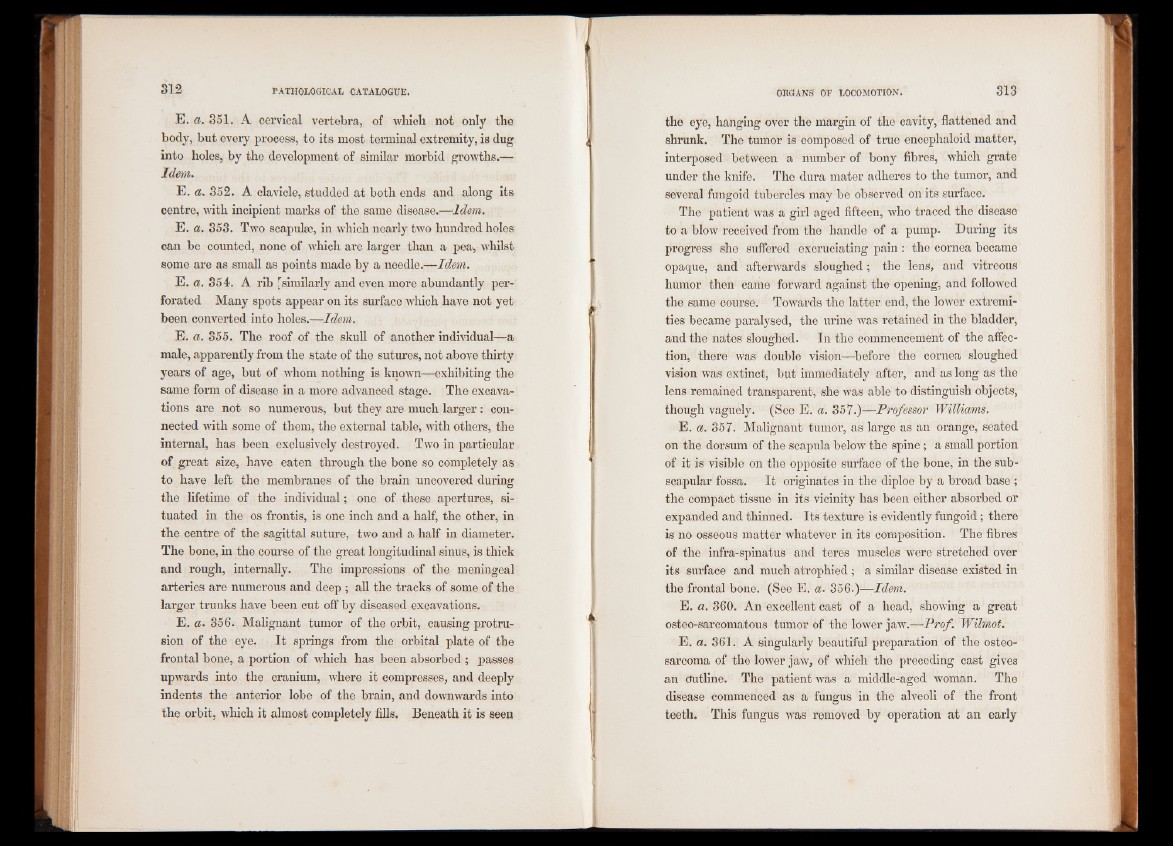
E. a. 351. A cervical vertebra, of which not only the
body, but every process, to its most terminal extremity, is dug
into holes, by the development of similar morbid growths.—
Idem.
E. a. 352. A clavicle, studded at both ends and along its
centre, with incipient marks of the same disease.—Idem.
E. a. 353. Two scapuke, in which nearly two hundred holes
can be counted, none of which are larger than a pea, whilst
some are as small as points made by a needle.—Idem.
E. a. 354. A rib ^similarly and even more abundantly perforated
Many spots appear on its surface which have not yet
been converted into holes.—Idem.
E. a. 355. The roof of the skull of another individual—a
male, apparently from the state of the sutures, not above thirty
years of age, but of whom nothing is known—exhibiting the
same form of disease in a more advanced stage. The excavations
are not so numerous, but they are much larger : connected
with some of them, the external table, with others, the
internal, has been exclusively destroyed. Two in particular
of great size, have eaten through the bone so completely as
to have left the membranes of the brain uncovered during
the lifetime of the individual; one of these apertures, situated
in the os frontis, is one inch and a half, the other, in
the centre of the sagittal suture, two and a half in diameter.
The bone, in the course of the great longitudinal sinus, is thick
and rough, internally. The impressions of the meningeal
arteries are numerous and deep ; all the tracks of some of the
larger trunks have been cut off by diseased excavations.
E. a. 356. Malignant tumor of the orbit, causing protrusion
of the eye. It springs from the orbital plate of the
frontal bone, a portion of which has been absorbed ; passes
upwards into the cranium, where it compresses, and deeply
indents the anterior lobe of the brain, and downwards into
the orbit, which it almost completely fills. Beneath it is seen
the eye, hanging over the margin of the cavity, flattened and
shrunk. The tumor is composed of true encephaloid matter,
interposed between a number of bony fibres, which grate
under the knife. The dura mater adheres to the tumor, and
several fungoid tubercles may be observed on its surface.
The patient was a girl aged fifteen, who traced the disease
to a blow received from the handle of a pump. During its
progress she suffered excruciating pain : the cornea became
opaque, and afterwards sloughed; the lens, and vitreous
humor then came forward against the opening, and followed
the same course. Towards the latter end, the lower extremities
became paralysed, the urine was retained in the bladder,
and the nates sloughed. In the commencement of the affection,
there was double vision—before the cornea sloughed
vision was extinct, but immediately after, and as long as the
lens remained transparent, she was able to distinguish objects,
though vaguely. (See E. a. 357.)—Professor Williams.
E. a. 357. Malignant tumor, as large as an orange, seated
on the dorsum of the scapula below the spine; a small portion
of it is visible on the opposite surface of the bone, in the sub-
scapular fossa. It originates in the diploe by a broad base ;
the compact tissue in its vicinity has been either absorbed or
expanded and thinned. Its texture is evidently fungoid; there
is no osseous matter whatever in its composition. The fibres
of the infra-spinatus and teres muscles were stretched over
its surface and much atrophied; a similar disease existed in
the frontal bone. (See E. a. 356.)—-Idem.
E. a. 360. An excellent cast of a head, showing a great
osteo-sarcomatous tumor of the lower jaw.—Prof. Wilmot.
E. a. 361. A singularly beautiful preparation of the osteosarcoma
of the lower jaw, of which the preceding cast gives
an outline. The patient was a middle-aged woman. The
disease commenced as a fungus in the alveoli of the front
teeth. This fungus was removed by operation at an early